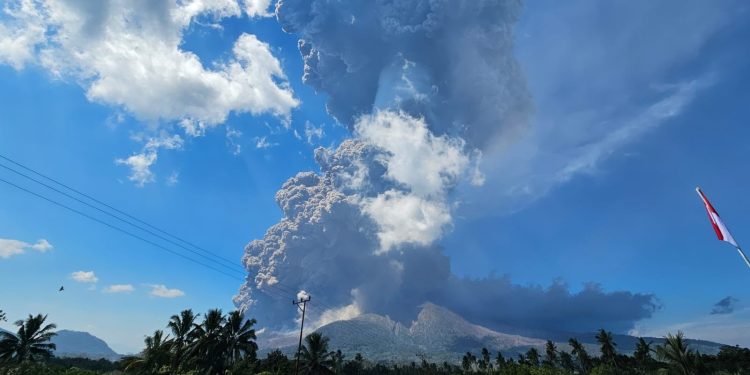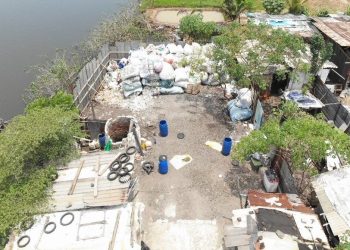Jakarta, Indonesia Sentinel — A powerful eruption from Mount Lewotobi Laki-Laki on Flores Island, East Nusa Tenggara, sent a massive ash plume soaring up to 18 kilometers above the summit on Monday, July 7, 2025. The volcano also spewed volcanic material, including sand and gravel.
The eruption occurred at 11:05 a.m. local time, marking one of the most significant volcanic events from the volcano, located in East Flores Regency.
The Lewotobi Volcano Observation Post reported that the ash column was thick and dark gray to black in color, drifting toward the north, northeast, and northwest.
“This eruption was recorded on the seismogram with a maximum amplitude of 47.3 millimeters and a duration of approximately six minutes and 26 seconds,” said Fajaruddin M. Balido, an officer at the Lewotobi Laki-Laki Volcano Observation Post.
Loud booms accompanied the eruption, and pyroclastic flows traveled up to 5 kilometers to the north and northeast. Moderate ashfall and gravel rain were also reported in the surrounding areas.
“Currently, the observation post is experiencing moderate ash and gravel rain,” Fajaruddin added in an official statement.
So far, no casualties or injuries have been reported, according to Avelina, Head of Emergency and Logistics at the East Flores Disaster Management Agency (BPBD), as quoted by CNN Indonesia.
However, joint teams from the police, military, and emergency response units are continuing to assess the situation and monitor affected areas. Vital public facilities, including hospitals and fuel stations in the town of Larantuka, remain unaffected at this time, Avelina said.
Read Also:
Earth Rotation Expected to Speed Up in Juli-August 2025, Shortening the Days
Mount Lewotobi Laki-Laki is currently at Alert Level IV (the highest warning level), indicating a major threat. The Geological Agency of Indonesia reported that as of noon Monday, the volcano was showing continuous explosive activity and ongoing volcanic tremors. Other seismic signals indicate ongoing magma supply and fluid movement toward the surface.
Drone surveillance revealed significant lava accumulation within the crater, adding to concerns about possible follow-up eruptions.
Given the current alert level, authorities have urged residents and tourists to stay out of a 6-kilometer exclusion zone around the crater and up to 7 kilometers to the southwest and northeast sectors.
Indonesian authorities are continuing to monitor the situation closely and have called for vigilance as volcanic activity remains high.
(Raidi/Agung)


























